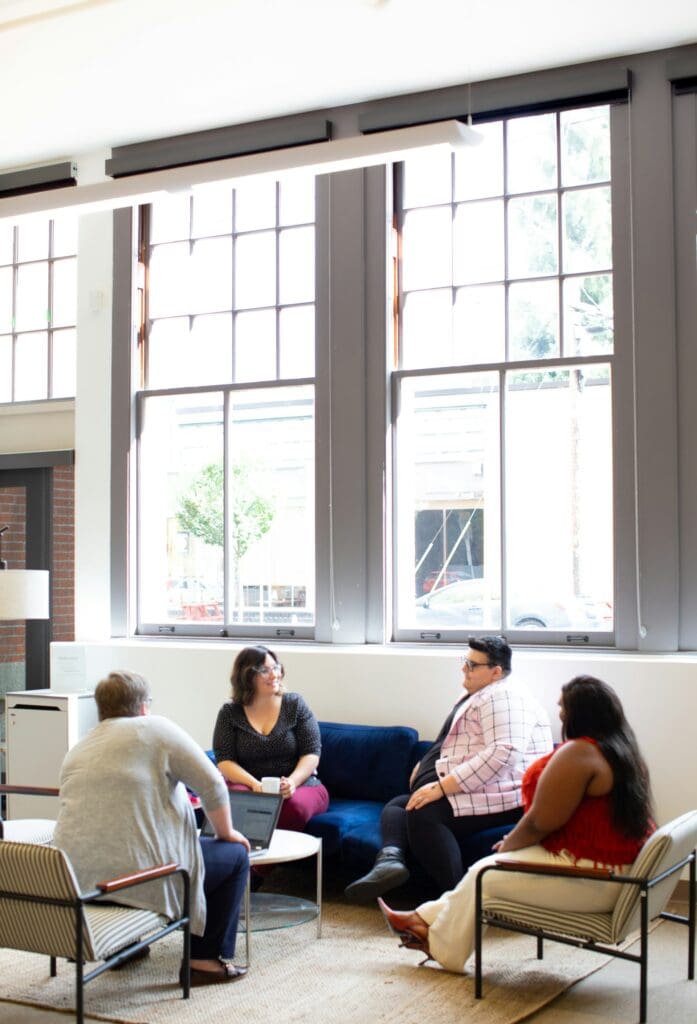Hello & welcome!
We serve individuals, couples, and families through virtual and in-person therapy in Maryland.
book an appointment
Why Group Therapy Works for Teens with ADHD and Autism
July 16, 2025
How Group Therapy Helps Teens with ADHD and Autism Build Confidence and Connection

Photo by Alex Green
When teens are diagnosed with ADHD or autism, everyday experiences like school, friendships, and family life can become overwhelming. Challenges with social situations, emotional regulation, and focus are common, and they often impact a teen’s confidence and independence.
While one-on-one therapy can be helpful, group therapy for teens offers a different kind of support. In a group setting, teens have the chance to connect with peers, share experiences, and practice important social and communication skills in real time.
The benefits of group therapy go beyond emotional support. Group sessions provide structure, routine, and skill-building opportunities that are especially helpful for neurodivergent teens. These sessions encourage cooperation, empathy, and problem-solving in a way that feels natural and engaging.
Choosing the right group therapy ideas for teens is essential. Activities should be tailored to the unique needs of teens with ADHD and autism, helping them build confidence, express themselves, and navigate relationships more effectively.
In this blog, we’ll explore why group therapy works so well for teens with ADHD and autism. We’ll also share practical therapy goals, session strategies, and creative group therapy ideas for teens that support long-term emotional and social growth.
Understanding the Benefits of Group Therapy for Neurodivergent Teens

Photo by AllGo – An App For Plus Size People
The benefits of group therapy extend beyond talk-based support. For teens with ADHD or autism, the group setting provides:
- A sense of shared experience
- A safe space to practice social skills
- Structured opportunities for self-expression
- Peer feedback that builds emotional intelligence
- A way to reduce feelings of isolation
While individual therapy offers personalized attention, group therapy for teens creates a supportive community where learning happens through shared experience. In a group setting, teens can hear from others who face similar challenges, helping them feel understood and less alone.
This peer-based model allows teens to observe real-time examples of healthy behavior. They see how others handle frustration, express emotions, and solve problems. Over time, they begin to model these same positive behaviors in their own lives.
For teens with ADHD, maintaining focus during one-on-one therapy can be difficult. Group therapy introduces variety and interaction, which helps keep them engaged. The natural flow of conversation and activities makes it easier for them to stay present and involved.
The group setting also reinforces social and emotional skills through practice rather than instruction. Rather than just talking about what to do, teens are given space to try out new communication styles, self-regulation tools, and coping techniques in a low-pressure environment.
This combination of structure, connection, and repetition is a key reason why the benefits of group therapy are so effective for teens with ADHD and autism.
Top Group Therapy Ideas for Teens with ADHD and Autism

Photo by Priscilla Du Preez 🇨🇦
Selecting the right group therapy ideas for teens requires an understanding of developmental levels, interests, and emotional goals. Activities should promote communication, self-regulation, and confidence.
Here are evidence-based and therapist-recommended ideas that work particularly well:
1. Social Scenarios Role Play
Teens act out challenging social situations (like handling teasing, joining a group conversation, or managing conflict). This helps them:
- Build social awareness
- Practice verbal and nonverbal communication
- Strengthen problem-solving skills
2. Mindfulness and Grounding Groups
Mindfulness activities can be adapted for teens with ADHD or autism using sensory-friendly tools or visual supports. Benefits include:
- Improved emotional regulation
- Increased attention span
- Better stress response
3. Creative Expression Through Art or Music
Teens often find it easier to express themselves through creative outlets. Art-based group sessions promote:
- Emotional processing without pressure
- Shared creativity and bonding
- Self-esteem development
4. Peer-Led Sharing Circles
Allowing teens to lead conversations about their experiences gives them ownership and boosts confidence. These groups focus on:
- Listening skills
- Empathy building
- Healthy peer interaction
5. Goal-Setting and Achievement Boards
Incorporating visual boards or goal-setting journals into sessions encourages teens to focus on growth. This helps reinforce:
- Motivation and task initiation
- Personal accountability
- Executive function development
Each of these activities can be adapted based on sensory needs, communication levels, and attention spans, ensuring that the group remains inclusive and effective.
Why Group Therapy is More Than Just Support: Functional Skills for Daily Life

Photo by Sincerely Media
One of the most important benefits of group therapy is its ability to teach real-world skills in a setting that feels safe and supportive.
For teens with ADHD and autism, everyday responsibilities like managing schoolwork, joining group activities, or handling family routines can often feel overwhelming. These situations require a combination of emotional regulation, planning, and communication skills that don’t always come naturally but can absolutely be learned.
Group therapy gives teens the chance to practice these abilities in a structured environment, with the guidance of a therapist and support from peers.
Instead of just being told what to do, teens actively engage in group activities that promote healthy habits, social awareness, and self-discipline. This kind of learning is hands-on and immediately relevant to their daily lives.
Group therapy helps teens:
- Practice routine-building strategies
- Navigate emotional ups and downs in real time
- Strengthen teamwork and communication skills
- Learn accountability and shared responsibility
These are the same skills teens will carry into adulthood.
Whether they are preparing for college, entering the workforce, or building independent routines, the lessons learned in group therapy can have lasting impact. By participating in group sessions that mirror real-life scenarios, teens gain more than just emotional support, they gain tools they can use every day.
This is one of the key benefits of group therapy. It helps teens move beyond understanding in theory and start applying their skills with confidence in real-life situations.
How to Choose the Right Group Therapy Format

Photo by Caroline Badran
Not every group therapy setting looks the same.
The structure, goals, and approach can vary depending on the needs of the teens involved. For adolescents with ADHD and autism, it’s especially important to find a group therapy format that is supportive, engaging, and developmentally appropriate.
Different types of group therapy serve different purposes.
Some are more focused on building life skills, while others provide emotional education or peer connection. The most effective groups often combine multiple elements to meet teens where they are socially, emotionally, and cognitively.
Here are a few formats that are especially successful for teens with ADHD and autism:
- Skills-based groups: Focus on building specific abilities like time management, social interaction, or anger management.
- Psychoeducational groups: Offer structured education on emotional topics like anxiety, depression, or impulse control.
- Support-based groups: Allow open sharing while reinforcing positive coping strategies and peer validation.
When evaluating options, families should prioritize programs that are designed with neurodiverse teens in mind.
Look for providers who understand ADHD and autism, and who are experienced in working with adolescents. A successful group should be age-appropriate, sensory-sensitive, and clearly structured with achievable goals.
Choosing the right format plays a major role in how well teens respond to group therapy. With the right fit, teens are more likely to stay engaged, build meaningful connections, and benefit from the group experience in ways that support their long-term growth.
Key Takeaways: The Benefits of Group Therapy for Teens with ADHD and Autism

Photo by Alex Green
Group therapy works because it mirrors the social dynamics teens face every day.
Whether at school, home, or in their community, teens are constantly navigating relationships and group environments. For teens with ADHD and autism, these experiences can be confusing or overwhelming without the right support.
Group therapy offers a space to practice these interactions in a way that is structured, safe, and purposeful.
In a group setting, teens don’t just receive support, they actively participate in it. They learn how to express themselves, listen to others, and respond to feedback.
These are essential skills for building self-awareness and healthy relationships. Over time, teens begin to relate to others with more confidence, and they also develop a clearer understanding of their own strengths and challenges.
Group therapy helps neurodivergent teens:
- Feel seen and understood
- Practice critical social and emotional skills
- Build real friendships and peer connections
- Improve communication and focus
- Navigate challenges with the support of others
The benefits of group therapy are especially meaningful for neurodivergent teens who may feel isolated or misunderstood.
Group sessions provide an opportunity to feel seen, valued, and connected. With the right group therapy ideas for teens in place, these sessions create an environment where growth happens naturally.
When group therapy is thoughtfully designed, it becomes more than a support system, it becomes a transformative experience that helps teens thrive socially, emotionally, and academically.
Looking Ahead: Building Confidence and Resilience Through Group Therapy

Photo by Helena Lopes
As the mental health field evolves, more professionals are recognizing the power of community in healing. For teens with ADHD and autism, group therapy offers a unique blend of support, structure, and growth.
By engaging in thoughtfully designed sessions that meet them where they are, teens can gain tools that serve them for years to come.
If you’re considering therapy options, don’t overlook the impact that a well-run group can have. The benefits of group therapy reach far beyond the circle; it’s about building a better future together.
Support Your Teen’s Growth with In-Person Group Therapy at The JW Group

Photo of Janet Williams, LSCW-C from JW Therapy Group
The benefits of group therapy are especially powerful for teens with ADHD and autism when delivered in a supportive, in-person setting.
At The JW Group, we offer specialized group therapy for teens that focuses on building confidence, emotional regulation, and social skills through carefully structured sessions.
Our team understands the unique needs of neurodivergent teens and designs each session using evidence-based group therapy ideas for teens that are engaging, inclusive, and goal-driven. Whether your teen is struggling with focus, communication, or peer relationships, our programs are built to help them thrive in real-life situations—not just in the therapy room.
If you’re exploring the benefits of group therapy and want to give your teen the support they need to grow, connect, and succeed, reach out to The JW Group today to learn more about our in-person therapy options. Together, we can help your teen build the tools they need for a brighter future.